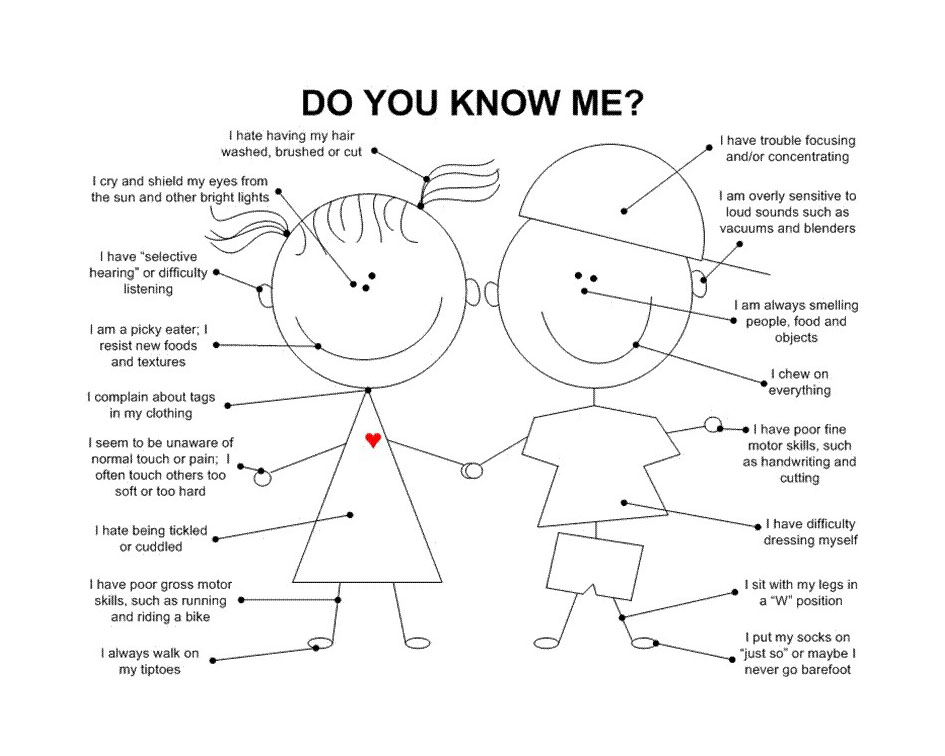What Is Sensory Processing Disorder?
Sensory Processing Disorder is hands down that most frustrating part of being an Autism parent, at least for me. For those unfamiliar with what I’m referring to when I say sensory issues, let me explain.
Sensory processing disorder is a condition that is very common in both kids and adults with Autism. What happens is their brains don’t properly interpret Sensory input correctly and this can be very problematic for them.
Sensory Processing Disorder can impact adults as well. I’m specifically referring to kids because that’s where my experience lies. Please don’t take that as anything else.
Kids with sensory processing disorder are hypersensitive to things like color, sight, sound, light, taste, texture, smells, and especially touch. How these sensitivities impact their lives can and will vary but there are commonalities.
Basically what happens is, kids with SPD will experience all sensory stimuli simultaneously and in amounts that compete overwhelm their ability to cope. Most people are able to filter out an external stimulus that is problematic but for kids with SPD, they simply can’t.
How Sensory Processing Disorder Impacts My Kids
Some of the common examples I hear from people are that they can hear the clock tick, lights hum, and even people writing with pencils around them. People dealing with Sensory Processing Disorder aren’t just experiencing sensory stimuli, they’re bombarded by it.. It is quite often painful and leads to overstimulation. That will later give birth to a meltdown, which is the body’s way of purging all the stress and anxiety built up over a period of time.
I speak only to my personal experience with my kids, but keep in mind that not all kids will experience things like this the same way. Likewise, how this impacts families will vary as well. Having said that, it’s widely accepted that sensory processing disorder is a truly horrible experience for kids to deal with on a daily basis.
All three of my little dudes are very sensory sensitive but not all to the same things and that presents many challenges.
There are two areas that my kids struggle with the most. These struggles impact them on a daily basis and affect the rest of us on a daily basis as well. Sensory processing disorder commonly manifests itself in extreme difficulty with food consumption. Both Elliott and Emmett are extremely when it comes to eating.
Things like food color, smell, taste, texture, visual presentation, physical packaging, imperfections in the food, or different food items on the same plate, will more often than not lead to them refusing to eat.
Not Just Picky Eaters
It’s important to understand that these kids are not just picky eaters and this is outside of their control.
Imagine the vilest thing you can even fathom eating. Something that makes you sick to your stomach just thinking about it. Something that you wouldn’t even consider ingesting, even if you were starving. Now multiply that by a million and you get a glimpse into what this is like for a kid with SPD to eat anything that is perceived to be sensory offensive.
Maybe the color of a chicken nugget is slightly off or the shape is imperfect, but otherwise, there’s absolutely nothing wrong with it. Despite it being perfectly normal and safe to eat, my kids with sensory processing disorder view it the same or even worse as the vile thing you were asked to image above.
I can’t even begin to explain how difficult it is to feed my kids. We can have plenty of delicious food but 98% of the time, they won’t touch it. They will literally starve themselves before they eat chicken nuggets from a company that has changed its packaging. They are exactly the same nuggets they were yesterday but if the packaging changes, even in the slightest, forget it.
It’s all about the way their brain perceives things.
Another massive challenge is in regards to clothes. This is particularly difficult for my youngest, as he’s the most profoundly impacted in this area.
This is a major challenge because the feeling of clothes on his skin is painful, uncomfortable, or itchy and most of the time, there’s no working through it. That doesn’t stop us from trying but more often than not, we have to try and work around it instead.
We can attempt to desensitize him with brushing, compression, or other sensory techniques that are designed to help him better tolerate the sensations. As I said, it’s never been wildly successful for us but your mileage will vary.
How To Be Supportive
The most common thing we do is simply try to work within the confines of his sensitivity. Things like seamless socks, shirts without tags, pants that aren’t too loose or too tight, and alternatives to shoes.
At this point in time, he hasn’t worn socks in forever. For that matter, all he can tolerate on his feet are crocs, but not just any crocs. They have to have a smooth inner sole and both crocs have to feel the same.
There have been many days of school missed over not being able to wear clothes.
It’s exhausting for them and it’s exhausting for us as parents.
It’s incredibly important not to force them to wear clothes that hurt or eat foods they find offensive. Doing so will make them unwilling to attempt to work through things in the future.
What we do is gently nudge them and encourage them to at least try to wear pants or taste the chicken nuggets, even though the package is different.
Sometimes it’s works out and other times, not so much. All we can do is be supportive, push a little bit, show compassion, and exercise patience. It’s much easier said than done at times but truthfully, it’s so much harder on them than it is on us, and it fucking sucks for us.




OMG i knew Tink had sensory issues, but not dx’d with SPD yet.
She has ALL of these.
That sounds like a huge challenge. My older son seems to have it more around people talking. Too much talking and he can’t listen.
My friend has a son who is 23 and he definitely has sensory disorders. He shuts down from too much happening. With his living situation I don’t see that improving. 🙁
I don’t deal with this personally but I can see how it impacts the rest of my family, including Lizze. They all have different struggles and deal with it in different ways. It’s not easy..